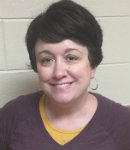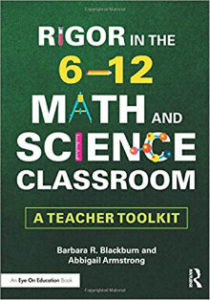Bringing Rigor and Engagement to Math and Science Classes
Rigor in the 6-12 Math and Science Classroom – A Teacher Toolkit
By Barbara R. Blackburn and Abbigail Armstrong
(Routledge/Eye On Education, 2019 – Learn more)

Barbara Blackburn always provides her readers with solid, easy-to-implement strategies for any classroom. In her latest book, Blackburn and co-author Abbigail Armstrong give clear definitions for “rigor” and how to apply rigorous instruction in any math or science setting in middle or high school.
Setting up a rigorous classroom environment that motivates student learners is a challenge for all teachers in this technology-driven age.
The authors tell us that, by showing our students the value of what they are learning and how that learning will help them in their lives, and by providing opportunities for their success, teachers will spur students to be motivated to learn!

As teachers, we need to be helping students learn to be more self-sufficient. They will not survive in their future workplaces without being motivated learners.
Even as a veteran science teacher, I find this book reminds me that I need to do a better job of some of the things I am already doing. My students won’t learn if I become complacent! I, too, need to break out of my comfort zone and try new things.
As such, I am interested in exploring more problem- and project-based learning opportunities for my classes. They will take more ownership of their learning, and I will see more of what they really know than I ever have before.
Some of my favorite strategies from the book that I would like to try in my classroom are:
- “Layering Meaning” – this is particularly good for teaching students new information when they do not read on grade level.
- “Three-Column Note Taking” – this is a strategy used with ESOL students in which students not only take notes on the information being presented, but also draw pictures to represent those notes. It really can help all students in science.
- “Pizza Wheel” – a great tool for reviewing information. (See what these teachers did with the idea!)
I also learned ways to improve my questioning techniques. Too often, I fall back on standard recall types of questions. In order to get my students thinking more, I need to improve my questioning techniques, especially when one of my goals is formative assessment. One strategy that I was particularly interested in for this was using 3-column matching questions instead of the traditional 2 columns. This gets the students thinking more, thereby increasing rigor!
All in all, Blackburn, with Armstrong’s support, has once again given teachers a practical yet powerful classroom instructional tool. I am looking forward to sharing these ideas with my fellow teachers!
Jennifer Sexton is a public school teacher in South Carolina. She has taught 6th grade science for 20 years. Jennifer has served in many capacities during her career, including team leader, department chair, mentor teacher and teacher evaluator. In addition to her Bachelor’s Degree in Biology from Erskine College and a Master’s Degree in Middle Level Education from Winthrop University, Jennifer earned her National Board Certification in Early Adolescent Science in 2009. She was school “Teacher of the Year” in 2012. Jennifer lives in western York County, SC with her husband, son and silly dog.






























